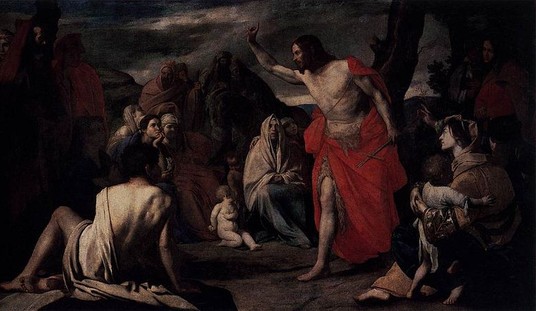Did Jill Stein help elect Donald Trump the first time around? That claim apparently remains fixed in the mythologies of 2016, at least among Democrats who still need some explanation of it other than Hillary Clinton’s incompetence as a candidate. Politico plays along with the charade this morning, claiming that Team Biden blindness to Green Party nominee and declared “democratic socialist” Howie Hawkins could cost them the 2020 election, too:
Jill Stein still haunts Hillary Clinton’s campaign team.
“Oh woof. I can’t bear to talk about that,” said former communications director Jennifer Palmieri.
For good reason: Had voters in Pennsylvania, Michigan, and Wisconsin cast their ballots for Clinton rather than the Green Party’s Stein, Clinton would be president.
Now, with the Green Party set to elevate its presumptive nominee — Howie Hawkins, a longtime labor activist keen on attracting disillusioned Bernie Sanders voters and calling for a “#DemExit” — many Democrats are unfazed. Not to worry, they say: Trump will be a sufficiently mobilizing force for Democrats this time around.
Well, maybe, but first of all, one has to believe that every Jill Stein vote would have gone to Clinton in Stein’s absence. The Greens have been around for a while, though, and field presidential nominees every election cycle. This is mainly a rehash of the Ralph Nader complaint from 2000, when Nader scored more votes as the Green nominee than the gap between Al Gore and George W. Bush. If Nader hadn’t been in the race, would those votes have gone to Gore? Possibly, but they might not have been cast at all, or gone to some other minor-party candidate too.
What makes this argument especially suspect is that Stein wasn’t a third-party candidate in 2016; she was a fourth-party candidate. Gary Johnson won three times as many votes nationwide for the Libertarians as Stein did for the Greens. It’s just as easy to argue that Trump would have won the lion’s share of Johnson’s votes in 2016 if Libertarians had suddenly disappeared as it is to claim that Stein ate up Hillary’s votes. Let’s take a look at the votes for Johnson and Stein in those states:
- Pennsylvania: Johnson 146,715, Stein 49,941
- Michigan: Johnson 172,136, Stein 51,463
- Wisconsin: Johnson 106,674, Stein 31,072
That 3:1 ratio holds up pretty well in all three blue-wall states. In fact, there’s a better argument that Libertarians might have drained more votes from Trump. Johnson was a well-known and fairly popular conservo-libertarian Republican governor who served two terms in New Mexico before going big-L Libertarian. Had Libertarians nominated a more obscure candidate, as is their usual wont, it seems at least more arguable that some of the Republicans who cast ballots for Johnson might have stuck with Trump.
But these aren’t the numbers that matter anyway. The reason Hillary Clinton lost wasn’t that Jill Stein stole those votes away from her — it was because Hillary Clinton lost many many more votes that had turned out four years earlier, especially in these three states. I wrote about it nearly two years ago when analyzing why Republicans got shellacked in the midterms:
In 2016, Clinton won 1.37 million Minnesota votes. Barack Obama had won 1.55 million four years earlier. Trump only added 2,000 to Mitt Romney’s 2012 total, hardly much motion at all. But that was enough for Trump to come closer than any Republican since Ronald Reagan to winning the state. However, he did it by standing still as Clinton underperformed. When Democrats show up to vote, Minnesota reverts back to its blue-state identity.
The same formula holds in the other three “blue wall” states. In Wisconsin, both Clinton (-238,000) and Trump (-5,000) underperfomed 2012’s results. Clinton dropped almost 300,000 votes from Obama’s 2012 performance in Michigan, which produced 131,000 fewer votes between the two major-party candidates than in the previous cycle. Pennsylvania is alone in having a higher combined 2016 vote total over 2012, but Clinton still came up short of Obama’s performance in the earlier cycle by 64,000 votes — and lost the state by 44,000.
Those numbers were preliminary at the time; Pennsylvania added a number of votes later as they firmed up the results. Let’s stack up the three states, this time comparing Hillary’s deficits to improvements for both Stein and Johnson between 2012 to 2016, as both ran in both cycles:
- Pennsylvania: Hillary +18,993, Stein +29,231, Johnson +97,957
- Michigan: Hillary -293,072, Stein +30,259, Johnson +96,724
- Wisconsin: Hillary -231,414, Stein +23,471, Johnson +86,395
Maybe one can make an argument that Stein’s presence made a difference in shifting votes from Democrats, but that’s weak at best. If you accept that premise, then you have to accept Johnson’s much more dramatic gains as evidence that he ate into Trump’s vote totals, and by a far more substantial margin than Stein impacted Clinton. In the other two states, the issue is much more clear — Hillary Clinton lost hundreds of thousands of votes because of Hillary Clinton, not because of Jill Stein.
The lesson from 2016 isn’t that Democrats have to worry about the Green candidate. It’s that they have to worry about their own nominee. Nominating Joe Biden is much more of an issue than Howie Hawkins ever will be.
Addendum: Republicans should have learned some lessons from 2016 and 2018 too, which is that turnout matters, and so does luck. Trump drew perhaps the only candidate who could have lost that 2016 election as an opponent, which was fortunate because he didn’t actually boost GOP turnout in Wisconsin or Michigan. If Biden can manage to boost turnout there, Trump may be in big trouble unless the RNC and Team Trump take GOTV a lot more seriously than they did in 2016.








Join the conversation as a VIP Member